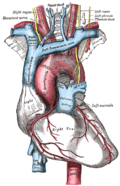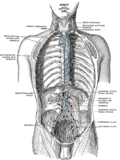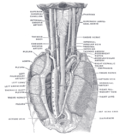Thoracic duct
Thoracic duct is the largest lymphatic vessel in the human body. It is responsible for transporting lymph from the lower and upper left quadrants of the body back to the bloodstream. The thoracic duct is a crucial part of the lymphatic system, which plays a key role in the body's immune response.
Anatomy[edit]
The thoracic duct originates in the abdomen from the confluence of the right and left lumbar trunks and the intestinal trunk, forming a significant pathway called the cisterna chyli. It traverses up through the diaphragm alongside the aorta and into the mediastinum where it drains into the venous system.
Function[edit]
The primary function of the thoracic duct is to transport lymph back to the bloodstream. Lymph is a clear, watery fluid that carries vital white blood cells that help fight infections. The thoracic duct collects lymph from the left side of the head, neck, and chest, the left upper extremity, and the entire body below the ribs. It then transports this lymph to the venous circulation at the junction of the left subclavian vein and the left internal jugular vein.
Clinical significance[edit]
Damage to the thoracic duct can result in a condition known as chylothorax, where lymph accumulates in the pleural cavity. This can occur due to surgical complications, trauma, or malignancy. Symptoms may include shortness of breath, cough, and chest pain. Treatment typically involves addressing the underlying cause and may include dietary modifications, medication, or surgery.
See also[edit]
References[edit]
<references />
|
|
|
-
Thoracic duct anatomy
-
Colored diagram of the thoracic duct
-
Diagram showing the parts of the body the lymphatic and thoracic ducts drain
-
Thoracic duct and surrounding structures
-
Thoracic duct in relation to the heart
-
Thoracic duct and lymphatic system
-
Thoracic duct and its connections
-
Photo of ductus thoracicus in human mediastinum
Ad. Transform your life with W8MD's Budget GLP-1 injections from $75


W8MD offers a medical weight loss program to lose weight in Philadelphia. Our physician-supervised medical weight loss provides:
- Weight loss injections in NYC (generic and brand names):
- Zepbound / Mounjaro, Wegovy / Ozempic, Saxenda
- Most insurances accepted or discounted self-pay rates. We will obtain insurance prior authorizations if needed.
- Generic GLP1 weight loss injections from $75 for the starting dose.
- Also offer prescription weight loss medications including Phentermine, Qsymia, Diethylpropion, Contrave etc.
NYC weight loss doctor appointmentsNYC weight loss doctor appointments
Start your NYC weight loss journey today at our NYC medical weight loss and Philadelphia medical weight loss clinics.
- Call 718-946-5500 to lose weight in NYC or for medical weight loss in Philadelphia 215-676-2334.
- Tags:NYC medical weight loss, Philadelphia lose weight Zepbound NYC, Budget GLP1 weight loss injections, Wegovy Philadelphia, Wegovy NYC, Philadelphia medical weight loss, Brookly weight loss and Wegovy NYC
|
WikiMD's Wellness Encyclopedia |
| Let Food Be Thy Medicine Medicine Thy Food - Hippocrates |
Medical Disclaimer: WikiMD is not a substitute for professional medical advice. The information on WikiMD is provided as an information resource only, may be incorrect, outdated or misleading, and is not to be used or relied on for any diagnostic or treatment purposes. Please consult your health care provider before making any healthcare decisions or for guidance about a specific medical condition. WikiMD expressly disclaims responsibility, and shall have no liability, for any damages, loss, injury, or liability whatsoever suffered as a result of your reliance on the information contained in this site. By visiting this site you agree to the foregoing terms and conditions, which may from time to time be changed or supplemented by WikiMD. If you do not agree to the foregoing terms and conditions, you should not enter or use this site. See full disclaimer.
Credits:Most images are courtesy of Wikimedia commons, and templates, categories Wikipedia, licensed under CC BY SA or similar.
Translate this page: - East Asian
中文,
日本,
한국어,
South Asian
हिन्दी,
தமிழ்,
తెలుగు,
Urdu,
ಕನ್ನಡ,
Southeast Asian
Indonesian,
Vietnamese,
Thai,
မြန်မာဘာသာ,
বাংলা
European
español,
Deutsch,
français,
Greek,
português do Brasil,
polski,
română,
русский,
Nederlands,
norsk,
svenska,
suomi,
Italian
Middle Eastern & African
عربى,
Turkish,
Persian,
Hebrew,
Afrikaans,
isiZulu,
Kiswahili,
Other
Bulgarian,
Hungarian,
Czech,
Swedish,
മലയാളം,
मराठी,
ਪੰਜਾਬੀ,
ગુજરાતી,
Portuguese,
Ukrainian









